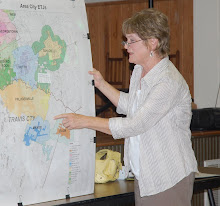Yesterday, from the Texas Transportation Forum, the Statesman’s Ben Wear report is headlined “Trans-Texas Corridor R.I.P.” To read the whole thing, go to
http://www.statesman.com/blogs/content/shared-gen/blogs/austin/traffic/index.html
“The Trans-Texas Corridor, as a name and as a guiding concept of the state’s transportation future, is dead, TxDOT executive director Amadeo Saenz told an audience of more than a thousand this morning at an Austin hotel.”
Showing that the issue will still be an issue in the 2010 governor’s race, “A spokesman for . . . U.S. Sen. Kay Bailey Hutchison, said that in fact the name isn’t the problem but rather the cross-state tollways associated with it and the rural land that would be needed to build them.”
As we reported at the time, “Outgoing Texas House Speaker Tom Craddick had created a stir a few months ago by declaring in an election forum that the Trans-Texas Corridor was dead. TxDOT officials at the time said, well, no, not exactly.”
“Saenz, at the Texas Transportation Forum at the Hilton Hotel, confirmed that the corridor’s death — or at least the death of its name — had in fact not been exaggerated.”
As described by TxDOT, the original Trans-Texas Corridor “vision,” or “nightmare” as residents called it, will not be pushed anymore. What TxDOT will do is “a series of smaller projects.” Included as one of these smaller projects will be SH 130, which is completed through Williamson County. This announcement seems to confirm what some have already been saying—that 130, and only 130, with no more land taken for any more Corridor development, will be the route of TTC-35 through Williamson County.
Replacing Perry’s 2002 plan, called “Crossroads of the Americas,” which called for 4,000 miles of 1,200-foot wide corridors criss-crossing the state, is a new document called “Innovative Connectivity in Texas/Vision 2009. You can see it at
http://www.keeptexasmoving.com/var/files/File/Vision_2009_Brochure.pdf
The “Innovative Connectivity” brochure is not a white flag on TxDOT’s part, but does mark a recognition that its grandiose schemes were unrealistic pipe dreams. One encouraging point is the statement on page 3 that the right of way for new projects would rarely exceed 600 feet (the approximate width of a freeway with access roads, e.g. SH 130 at Pecan Street east of Pflugerville), rather than the quarter of a mile envisioned by TTC planners. On pages 8-9, TxDOT commits to using existing ROW whenever possible, before “breaking new ground,” a concept at odds with the TTC vision. When the TTC was first being introduced in 2003 to a small Austin gathering, unpublicized and attended by very few members of the public, TxDOT rolled out the TTC as a “green fields project.”
Corridor Watch’s David Stall says,"We think that today is a huge leap forward in getting control over transportation projects and seeing that they serve a transportation need and not just a revenue-generating role . . .The reality is the move that's been made today turns it from a statewide massive corridor project into a much more reasonable transportation project, which they should have been from the beginning.”
He continues,"We still need to particularly be wary of public-private partnerships which are to line the pockets of Wall Street financiers more than provide transportation for ordinary Texans.”
He calls today’s announcement “a major victory for farmers and ranchers.”
Wednesday, January 7, 2009
If not dead, at least Corridor is wounded
Subscribe to:
Post Comments (Atom)

No comments:
Post a Comment